This blog post introduces the six manuscripts written by and associated with Esther Inglis which are held at Edinburgh University Library. The cataloguing, conservation, and digitisation of this manuscript group forms an important output of “Esther Inglis 2024”. This post is written by the Project Curator.
Today, sixty-three manuscripts by Esther Inglis are known worldwide. This number includes manuscripts which are currently held in libraries or in private collections. It also includes manuscripts which are recorded in older auction catalogues or described in historical records. The total of sixty-three known Esther Inglis manuscripts is the highest it has ever been, but this number is constantly shifting. In 2012, two manuscripts previously considered Esther Inglis’ work were de-attributed in a new catalogue drawn up by Nicolas Barker. These manuscripts are now thought to be compilations of sixteenth-century calligraphic pieces which were gathered together by later owners. One of these manuscripts is in the National Library of Scotland — MS 2197. The other is MS La.III.522, held by the University of Edinburgh. So where did this original attribution to Esther Inglis come from, and how does it relate to the other five manuscripts in the University which she definitely did write?

The six Inglis-related manuscripts at the University of Edinburgh all came to the Library at the bequest of David Laing (1793-1878). Laing was a Scottish antiquary, a collector of manuscripts and a bibliographer. At his death, Laing left his manuscript collection to the University; the Laing collection is the largest single manuscript collection in the University Library. Laing was an important early collector of Esther Inglis’ manuscripts; in 1865, he published “Notes relating to Mrs Esther (Langlois or) Inglis, the celebrated calligraphist” in the Proceedings of the Society of Antiquarians of Scotland. Today, this extensive article continues to be cited by modern scholars as a source of bibliographical information not only for Esther Inglis, but also for her father Nicolas Anglois, husband Bartilmo Kello, and father-in-law John Kello. Laing’s article also describes 28 manuscripts by Inglis which he has either seen, heard of, or owns. Five of the six Inglis-related manuscripts now at the University of Edinburgh are included in this list; these are: MS La.III.440, MS La.III.439, MS La.III.75, MS La.III.525, MS La.III.522.
David Laing continued to collect manuscripts by Inglis after publishing his 1865 article; the manuscript now MS La.III.249 includes a note in Laing’s handwriting to say that he acquired it in 1867. The rest of this blog post will introduce this group of six manuscripts, which form the part of the core of the “Esther Inglis 2024” project.
Read on to meet the manuscripts…
La.III.440
This is one of Esther Inglis’ earliest dated manuscripts, produced in 1592. It contains the text of the hundred verses entitled De la grandeur de Dieu et de la cognoissance qu’on peur avoir de luy par ses oeuvres [On the greatness of God, and on the knowledge that one can have of him through his works], originally written by Pierre du Val and published as a printed book in 1553. Forty years after this first publication, Esther Inglis’ copies of these verses are intricate and decorative; she rewrites these hundred verses in twenty different styles of script, which vary dramatically in size and ornamentation. Esther Inglis’ manuscript has an oblong format; this is unusual for its time, but is likely to reference the shape of sixteenth-century handwriting manuals or “writing books”, which were designed to be laid flat on a table. However, Inglis’ manuscript measures just 9 by 12 centimetres, much smaller than any writing-book she might have seen. This little book draws its viewer in to new worlds of writing, through which to read the wonders of creation described within its text.
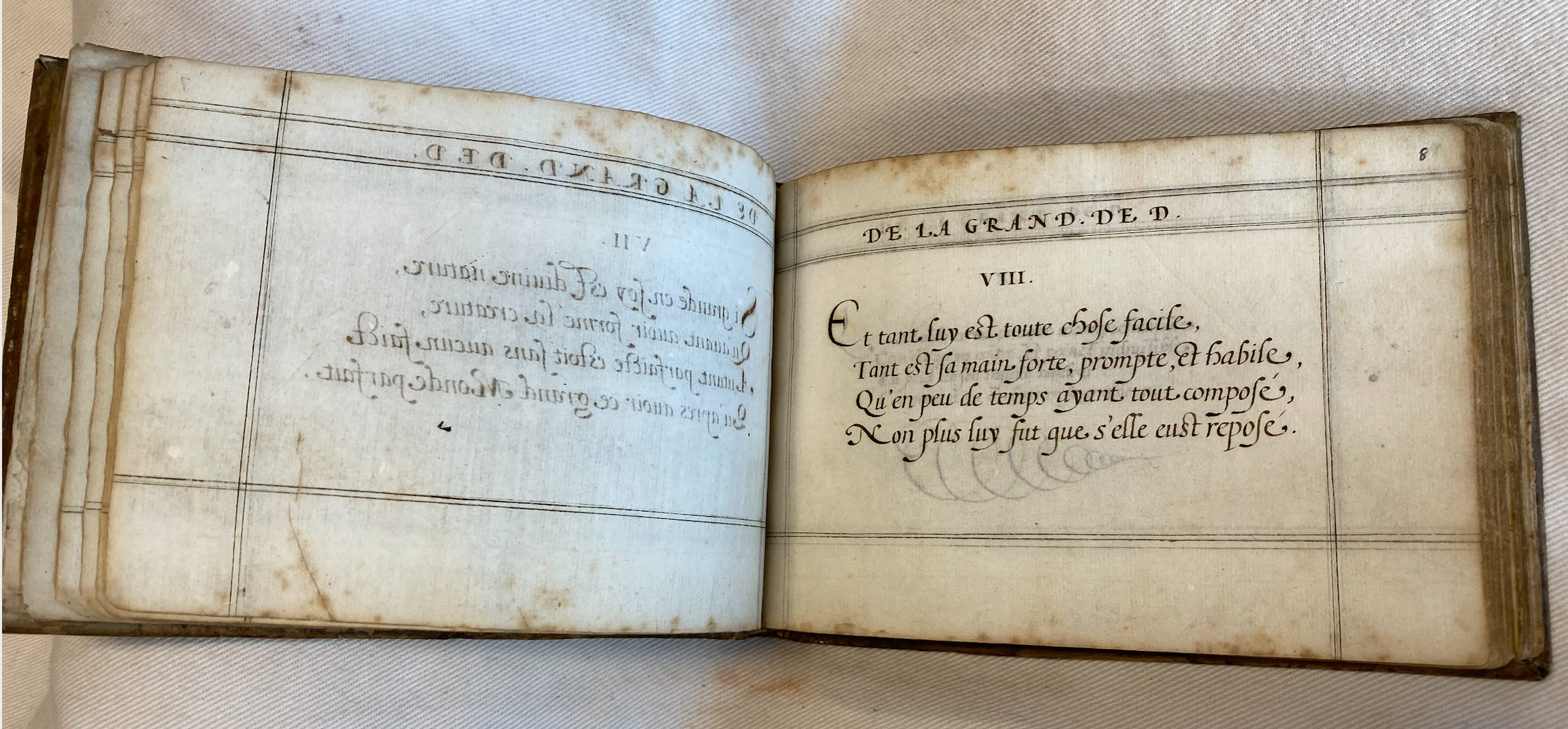
La.III.525
This manuscript is an example of a “friendship album”, or album amicorum, kept by the Edinburgh-born George Craig. An album amicorum collects signatures or inscriptions by individuals, perhaps friends of the album’s owner, or those who the owner met on their travels. On the 8th August 1604, Bartilmo Kello and Esther Inglis both added inscriptions to Craig’s album while they were in London. These inscriptions are facing each other, and offer a striking comparison between the scribal hands of husband and wife.
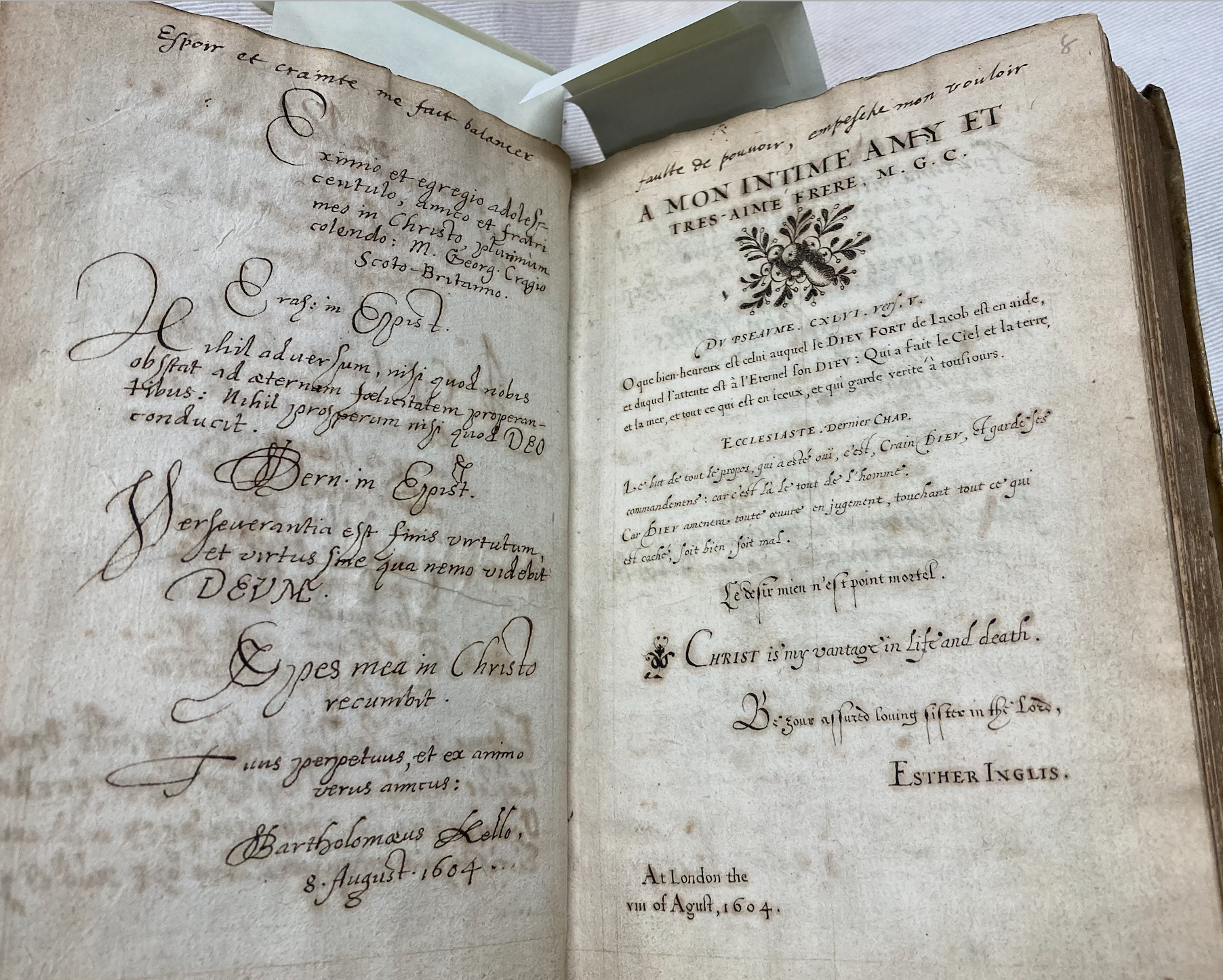
La.III.249
This manuscript is a rare example of Esther Inglis working on a scribal commission; it is a copy of of Book 2 of the Latin ‘Treatise on Union’ composed by David Hume of Godscroft (1558-c.1630). Written in 1605, the manuscript is a presentation copy which Hume may have intended to present to King James VI/I and Prince Henry Frederick, as the dedicatees of this work. Although her name is not written in this manuscript, Esther Inglis’ calligraphy is clear from both the quality of its script, and her subtle floral decoration.
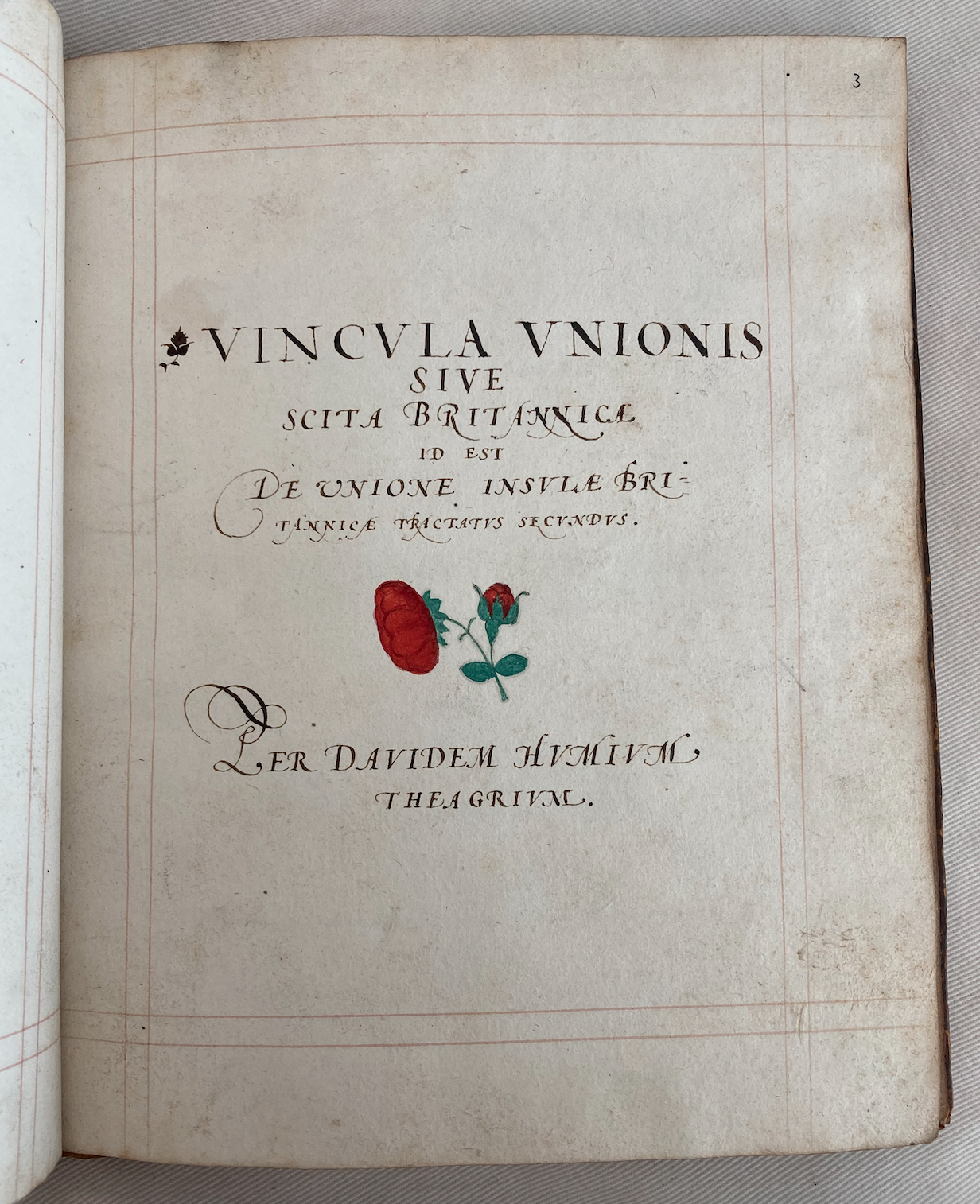
La.III.439
This manuscript, produced by Esther Inglis in 1606, contains a copy of the popular religious and moral Quatrains written by Guy du Faur, Seigneur de Pybrac. In 1607, Inglis gave her manuscript as a gift for the New Year to Robert Cecil (1563-1612), 1st Earl of Salisbury. Like many of the books made by Inglis between 1600 and 1608, this manuscript has a richly illuminated title-page with a floral border (see this blog post), and each of its calligraphic verses would originally have been accompanied by individual botanical decorations. This particular manuscript of Quatrains, however, has been subject to the collecting or collaging activities of a later reader; with just four exceptions, all of these botanical decorations within the main text have been cut out. The manuscript makes for a fascinating record of the changing value judgements which have been placed upon this miniature book in the centuries after its production.


La.III.75
This manuscript is a collaborative production between Esther Inglis and her husband, Bartilmo Kello. The couple produced this manuscript in 1608 as a gift for Sir David Murray of Gorthy, thanking him for having secured the position of rector for Bartilmo Kello in the parish of Willingale Spain, in Essex. The text is Kello’s English translation of Yves Rouspeau’s Traitté de la préparation à la saincte Cène de Nostre seul Sauveur et Rédempteur (1563); Kello titles his version A Treatise of Preparation to the Holy Supper and of our only Saviour and Redeemer Jesus Christ. Esther Inglis copies this text into her manuscript in scripts which closely imitate a printed book. Part of the intrigue of this manuscript lies in its print-like appearance, from its words to its layout, and this replication (or perfecting) of print is a technique which Inglis continues to develop across her career.
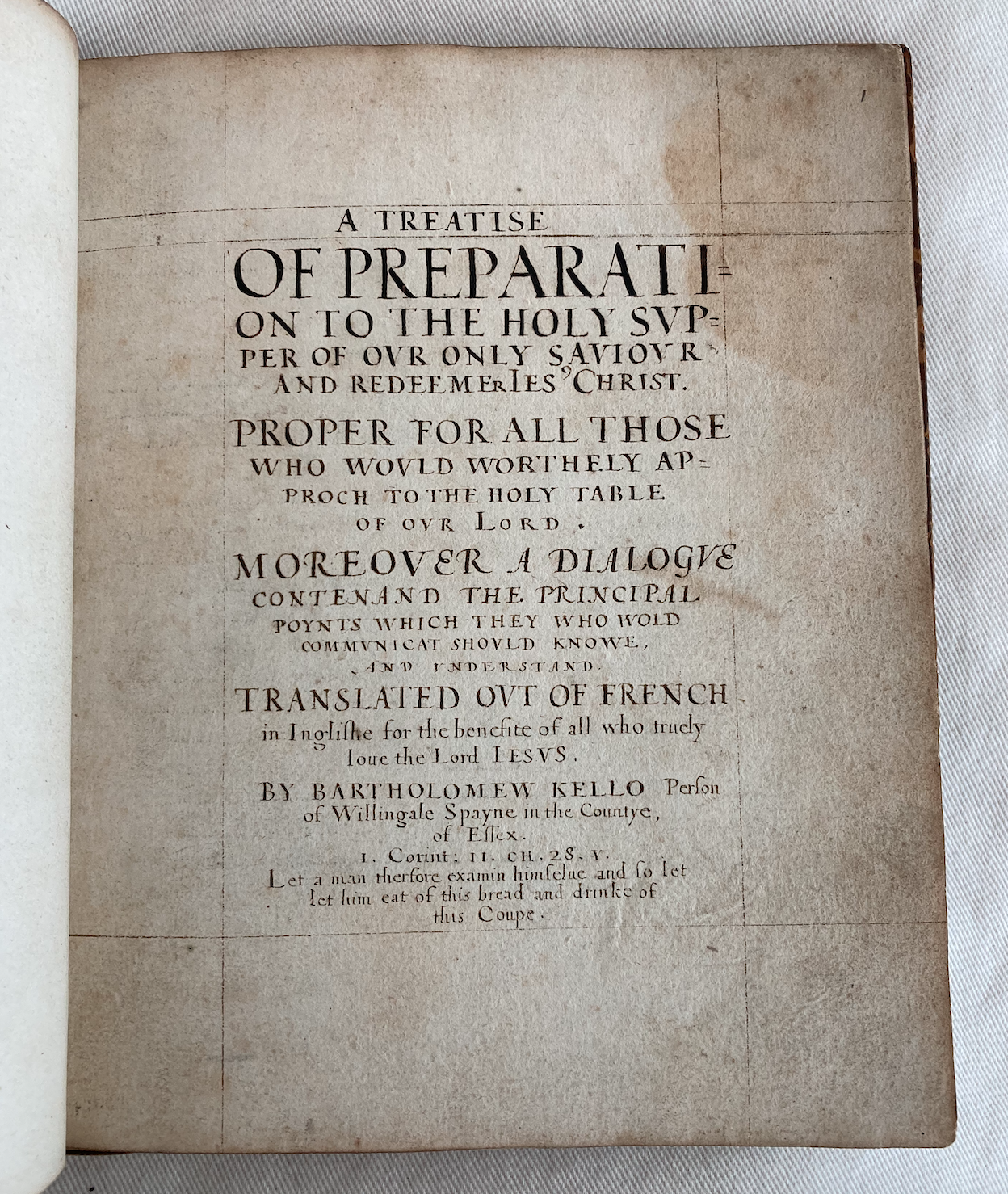
La.III.522
MS La.III.522 is not written by Esther Inglis herself, but instead is a composite manuscript of pieces assembled by a later collector. It contains several different collections of calligraphy samples now bound into one. Two of these collections follow the aspect and structure of early-modern writing-books; two decorative alphabet structure samples of writing in different kinds of script. One of these decorative alphabets is composed of gothic, knotwork intials, as shown below. Scripts and decoration are embellished with gold ink; these writing-books were presumably not produced as teaching samples, but to demonstrate the skills of particular writing masters.
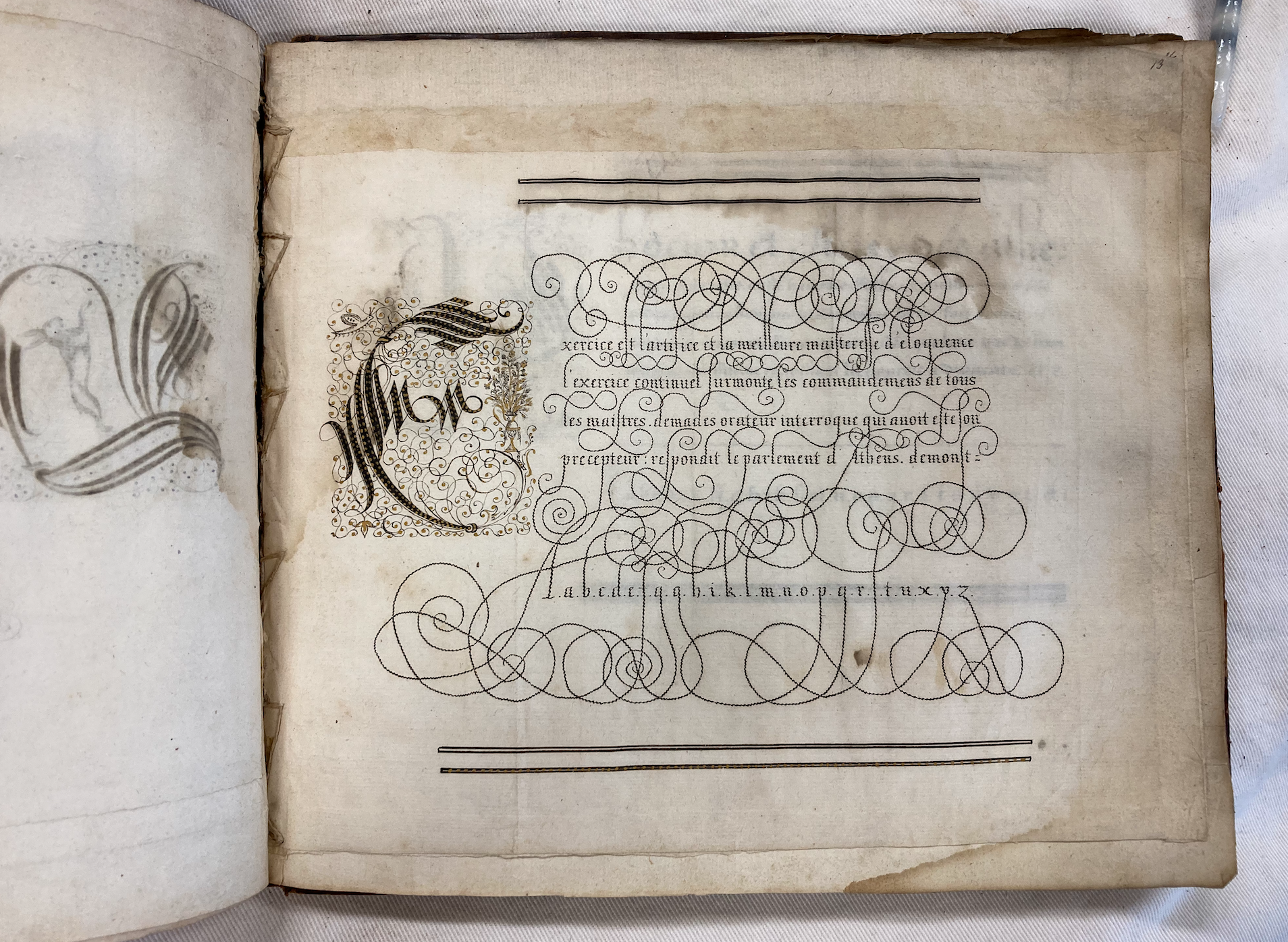
These alphabetised calligraphy samples, however, have since been bound with other materials. Nicolas Barker’s suggestion is that the compilation was made by Archibald Constable, whose son David Constable (1795-1857) later sold the manuscript to David Laing on the 18th December 1828. None of the items in the manuscript are dated, but several names of possible scribes appear. One section of its calligraphic pieces bears the name Jacques Dorsanne, and is dedicated to Philippe de Mornay (1549-1623), a Huguenot writer and supporter of Henry IV of France. Two further pieces, meanwhile, are signed by a William Geddie (d. 1624), a scribe who worked “at Barnetoun” [Barnton], in the outskirts of Edinburgh.
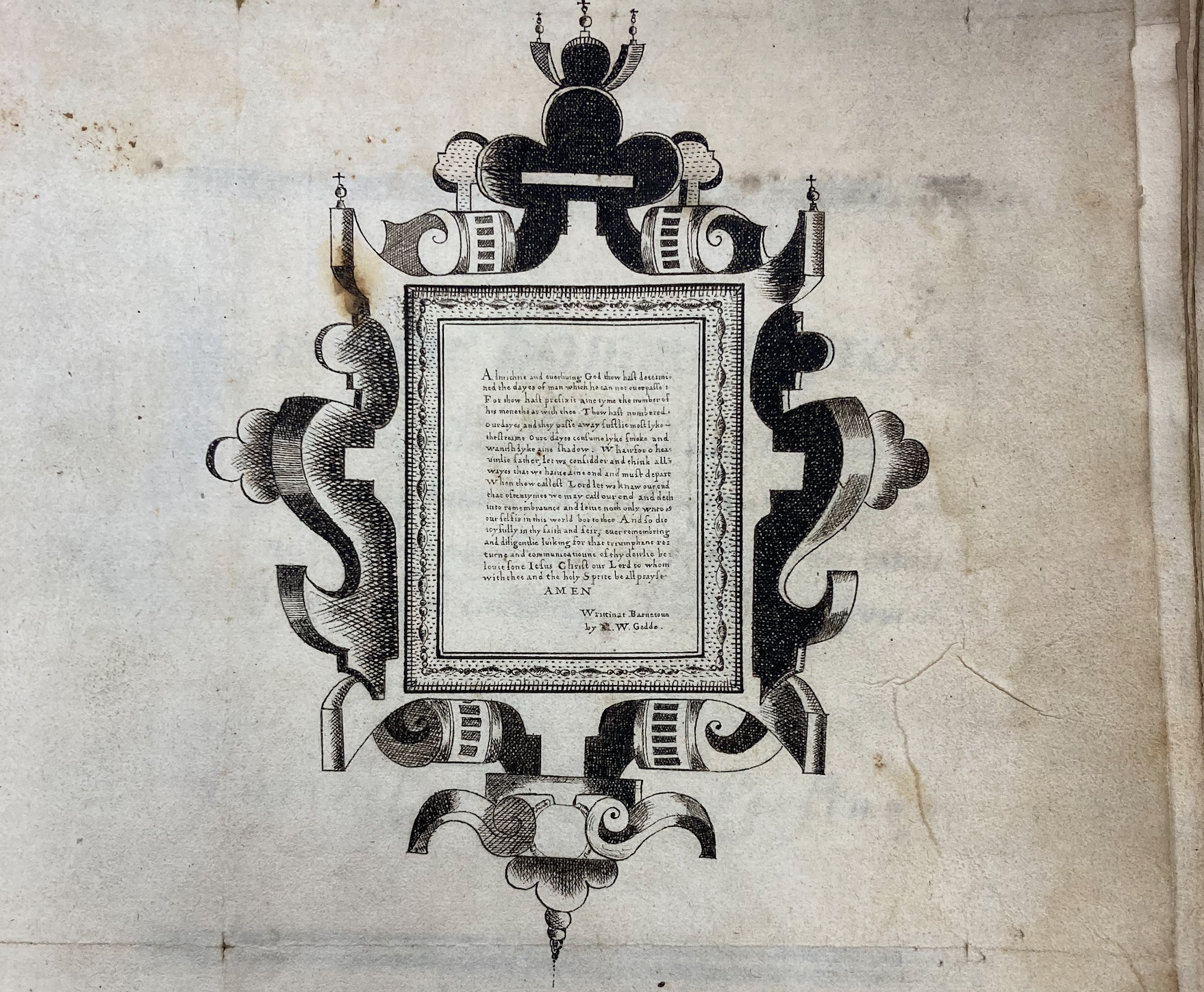
As Jamie Reid Baxter has shown, it is very likely that William Geddie was a relative of John Geddie, a scribe connected with the court of James VI. John Geddie is known to have copied a manuscript of George Buchanan’s poem De Sphaera [On the Sphere], which then passed to William Geddie. David Laing certainly thought that there was a connection between these two scribes; on the inner cover of this manuscript, he has added a transcription of a record from the 8th May 1577, which awards a yearly pension from George Buchanan to “his lovit Mr Johne Geddy”. As Jamie Reid Baxter and others have noticed, there are in turn clear connections between the style of decoration used in a presentation manuscript made by John Geddie for James VI in 1586, and the decorative borders and initials found in Esther Inglis’ own manuscripts produced between 1599 and 1602. This connection strongly suggests that Inglis herself knew John Geddie, and both Geddie scribes may have been part of her circle in late sixteenth-century Edinburgh.
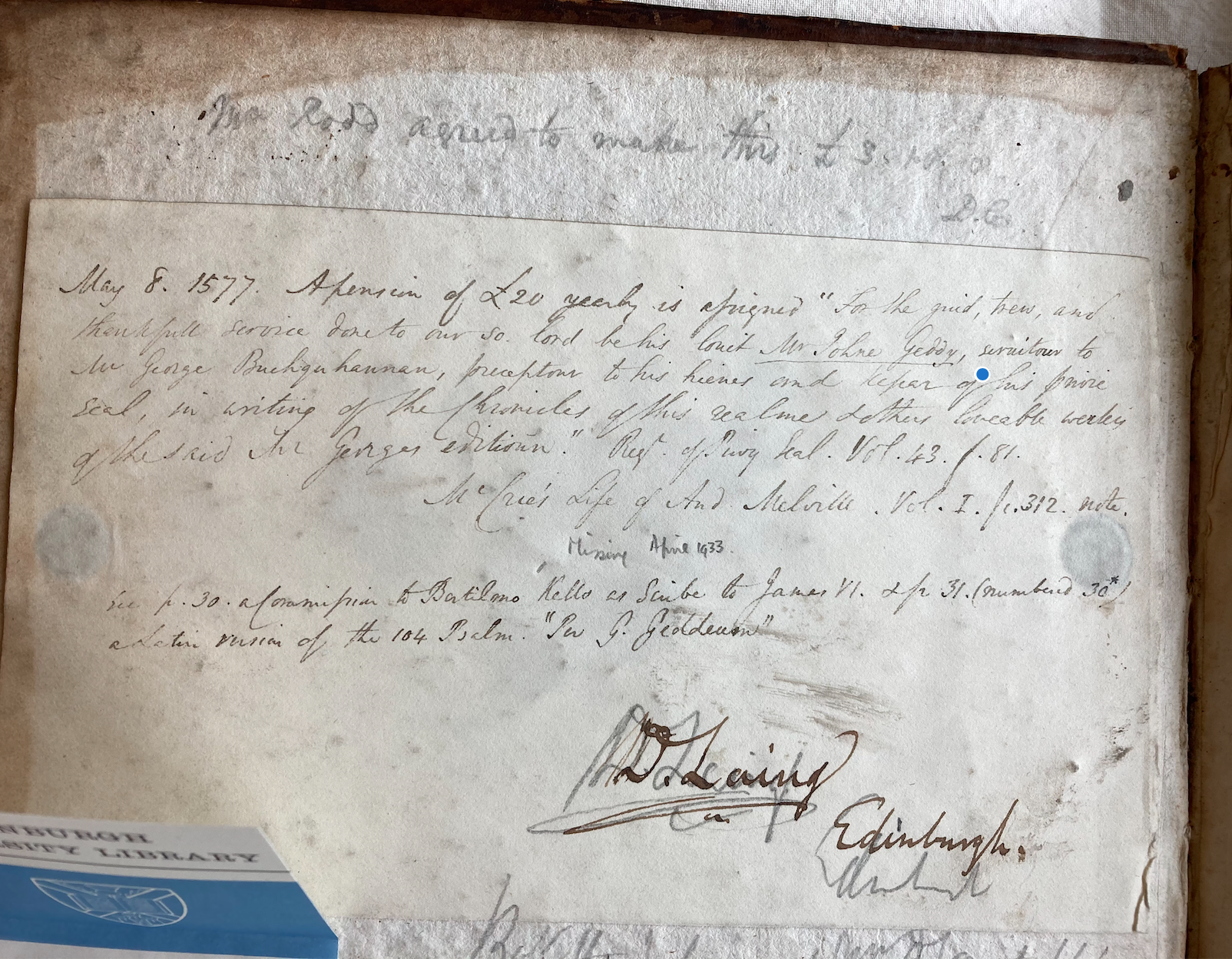
When David Laing published his description of this manuscript in 1865, he also noted the presence of one important document bound into the collection which has sadly since been lost. This document is a draft “warrant” which, had it ever been signed, would have appointed Bartilmo Kello to the position of “clerk of all passports” under King James VI/I. The text of this warrant also makes reference to “the mest exquisit wreater [writer] within this Realme” who was to assist in the writing of official documents under King James — Esther Inglis herself. The fact that Inglis herself is not named directly strongly suggests that her writing was already known within royal circles. By 1596-7, when this warrant is likely to have been drafted, neither she nor her calligraphy needed any introduction.
The presence of this draft warrant, together with the calligraphic nature of the rest of the items bound within this manuscript, presumably combined to invite David Laing’s attribution of MS La.III.522 to Esther Inglis in his 1865 “Notes” — an attribution which endured for the next 147 years. But the question remains whether the subsequent deattribution of this manuscript decreases its value or scholarly interest. And does this deattribution mean that MS La.III.522 has become less significant for the work of the “Esther Inglis 2024” project?
Far from it. As Project Curator, my own view is that Esther Inglis’ calligraphy can only be fully understood or appreciated when it is set alongside the productions of other scribes working in similar circles. MS La.III.522 contains the handwriting of other scribes working in and around Edinburgh at the same time as Inglis. How else can audiences measure the differences of what Inglis herself writes and draws, the influences which she calls upon, and the artists or writers to which she responds, if her work is not examined alongside the productions of these wider contexts? The contents and history of MS La.III.522 offer just such a touchstone against which to set Esther Inglis’ own manuscripts, the better to understand the exceptionality of what she, as a rare woman calligrapher known within the royal court, was able to accomplish.